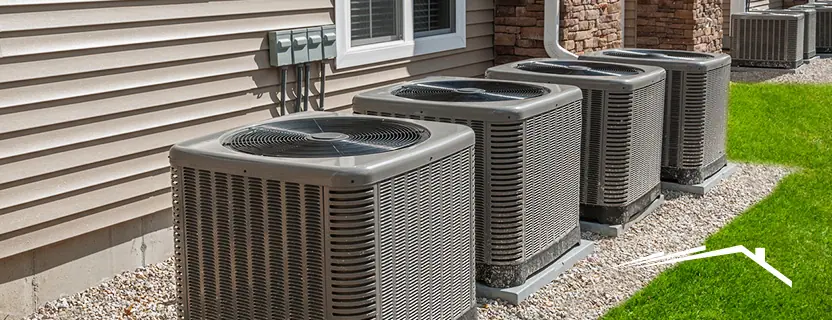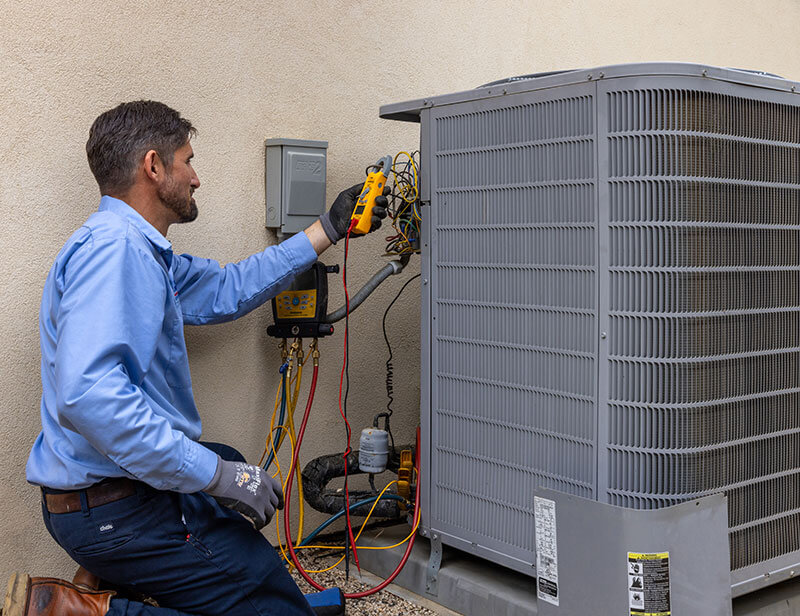Comparing Costs of Repair vs Full furnace replacement
Comparing Costs of Repair vs Full furnace replacement
Blog Article
How a Warmth Pump and Heating System Work Together to Optimize Your Home's Home heating Effectiveness
Understanding how a heatpump and furnace interact is necessary for property owners seeking reliable home heating solutions. Each system has its strengths, providing a balanced technique to home convenience. The warm pump stands out in moderate temperature levels, while the furnace provides rapid heat during severe cold. This synergy not only reduces energy prices but additionally boosts the lifespan of both home appliances. What elements affect this partnership, and how can house owners maximize their advantages?
Understanding Warm Pumps: Just How They Work
Although numerous individuals might be not familiar with their inner functions, heatpump play a crucial duty in modern home heating systems. These gadgets run by transferring warmth from one location to another, using the concepts of thermodynamics. In colder months, a heatpump removes heat from the outside air, ground, or water, and transfers it inside your home to warm up the living area. Conversely, throughout warmer months, it can turn around the process, functioning as an a/c by removing warm from inside to the outside.Heat pumps are composed of an evaporator, development, compressor, and condenser shutoff. The refrigerant within the system absorbs heat as it evaporates at reduced temperature levels and stress. The compressor after that boosts the stress and temperature level of the cooling agent, permitting it to release warm as it condenses. This effective procedure can considerably minimize energy usage compared to standard home heating methods, making heatpump a sustainable choice for environment control in homes.
The Role of Heating Systems in Home Home Heating
Heaters play a vital duty in home heating by providing a trustworthy resource of warmth during the colder months. They operate by creating warm via combustion or electric resistance, dispersing it throughout the home via ducts or radiant systems. The effectiveness of a heater is usually determined by its Yearly Gas Use Efficiency (AFUE) score, which shows just how effectively the unit transforms gas right into heat.Furnaces can use numerous power resources, including gas, electricity, oil, or lp, allowing homeowners to choose one of the most suitable option for their requirements. Unlike heatpump, which may struggle in extreme cool, furnaces maintain consistent efficiency, making certain that interior temperature levels stay comfortable no matter outside problems. In addition, modern furnaces frequently come outfitted with advanced innovation, such as variable-speed blowers and clever thermostats, boosting their efficiency and responsiveness. This adaptability makes furnaces a crucial component in all-inclusive home heating techniques.

Advantages of Utilizing Both Systems Together
Integrating the toughness of both heating systems and warmth pumps can lead to a much more reliable and effective home heating remedy. Using both systems enables property owners to benefit from the heatpump's energy efficiency during milder temperatures while relying upon the furnace for even more severe cold problems. This dual approach can substantially decrease energy costs, as heatpump consume much less power than traditional home heating methods when temperatures are moderate.Additionally, utilizing both systems with each other can boost convenience degrees in the home. Heatpump can supply consistent, also heating, while furnaces can swiftly increase ambient temperatures when needed. In addition, the integration of both systems can expand the life-span of tools by reducing damage on each unit, as they share the work. Ultimately, house owners can take pleasure in a balanced, cost-effective heating remedy that adjusts effortlessly to differing weather condition conditions, making certain a cozy and inviting home throughout the cold weather.
How Warm Pumps and Furnaces Complement Each Other
They produce a complementary heating system that makes the most of effectiveness and comfort when homeowners integrate heat pumps and furnaces. Warm pumps operate by transferring heat from the outside air or ground, making them extremely reliable in moderate environments. They stand out throughout milder temperature levels, providing economical heating. Alternatively, heating systems produce warm through combustion or electrical resistance, delivering solid, instant heat during severe cold conditions.The mix of these two systems permits for dynamic modifications based on temperature variations. During warmer months or milder winter season days, the warmth pump can take the lead, preserving power and minimizing expenses. As temperatures drop, the furnace can effortlessly involve, guaranteeing consistent heat throughout the home. This synergy not just optimizes power usage yet likewise improves the life expectancy of both systems, as each unit operates within its excellent performance range. Together, they create a well balanced setting that adapts to differing environment demands.
Enhancing Effectiveness: Tips for Homeowners
Property owners can improve their heating effectiveness with a number of functional approaches. Establishing ductless mini splits a normal upkeep timetable, incorporating wise thermostat innovation, and implementing reliable insulation and securing services are crucial actions. These measures not only improve comfort but additionally decrease power expenses.
Routine Maintenance Set Up
To ensure maximum heating effectiveness, developing a normal upkeep routine is necessary for any home. House owners need to prioritize routine examinations of both heatpump and heating systems to establish peak efficiency. This consists of altering air filters each to three months, as clogged filters can greatly lower effectiveness. Additionally, scheduling expert upkeep a minimum of annually allows technicians to determine and address potential concerns before they rise. Property owners ought to also cleanse the heatpump's outside device to avoid debris buildup that can impede airflow. By sticking to a regular upkeep schedule, property owners not only enhance their heater' effectiveness but additionally extend their lifespan, leading to better convenience and decreased energy expenses throughout the chillier months.
Smart Thermostat Integration
Incorporating a clever thermostat into a home heating system can considerably boost energy effectiveness, especially as it enables for exact control over temperature setups. These gadgets can find out the homeowner's timetable and preferences, automatically adjusting the temperature level to maximize convenience while reducing energy use. They can reduce heating during times when the home is unoccupied, reducing unneeded intake. Lots of wise thermostats likewise supply real-time energy usage information, enabling homeowners to make enlightened choices concerning their heating routines. Additionally, remote gain access to via smart device apps permits individuals to readjust setups from anywhere, making certain the home is cozy upon return. On the whole, wise thermostat integration not only enhances comfort but substantially contributes to power cost savings and performance.
Insulation and Securing Solutions
Smart thermostats play an essential duty in power performance, but their performance can be significantly boosted by correct insulation and sealing solutions. Homeowners ought to focus on protecting floorings, attics, and walls to decrease warmth loss. Premium insulation materials, such as spray foam or fiberglass, can considerably boost thermal resistance. Additionally, sealing voids around doors, ducts, and windows prevents cool air infiltration and warmth escape. Weatherstripping and caulking work techniques for addressing these leaks - heat pump service. Routine inspections for air leakages, in addition to the usage of blower door examinations, can assist determine trouble locations. By investing in insulation and sealing, property owners can optimize the performance of their heater, inevitably bring about reduced energy intake and reduced utility expenses
Usual Myths About Warmth Pumps and Furnaces
What misunderstandings surround heatpump and furnaces? Several people mistakenly think that heatpump are ineffective in cooler environments. Actually, contemporary heat pumps are made to run effectively even in reduced temperatures, providing trusted heating throughout winter. An additional common misconception is that furnaces are constantly a lot more efficient than warmth pumps. Nonetheless, this depends upon the specific energy resources and effectiveness ratings of the systems in inquiry. Some might likewise believe that making use of both systems all at once is unnecessary, yet as a matter of fact, this combination can enhance heating efficiency, specifically during extreme weather. Furthermore, individuals frequently assume that warm pumps call for constant upkeep, when in reality, they have similar upkeep needs to conventional heating unit. By unmasking these myths, property owners can make even more enlightened decisions regarding their heating options, eventually resulting in improved comfort and power performance in their homes.
Upkeep Considerations for Combined Equipments

Regularly Asked Inquiries
Can Heat Pumps Work Effectively in Exceptionally Cold Climates?
Warmth pumps can battle in exceptionally cold climates as a result of decreased efficiency and warm extraction limitations. Innovations in technology have led to models developed for far better performance in such conditions, improving their feasibility in rough settings.
Just How Long Do Warm Pumps and Furnaces Commonly Last?
Heat pumps usually last 15 to two decades, while furnaces have a life expectancy of 15 to thirty years. Routine upkeep can expand their durability, making sure reliable procedure and reducing the requirement for premature replacements.

What Is the Typical Price of Installing Both Equipments?
The typical cost of installing both a heat pump and a furnace generally ranges in between $5,000 to $10,000 - ductless mini splits. Variables affecting this price include system dimension, installation intricacy, and local labor prices
Exist Tax Obligation Motivations for Utilizing Energy-Efficient Heating Equipments?
Lots of home owners ask about tax obligation incentives for energy-efficient furnace. Different federal and state programs typically use credit scores or refunds, encouraging the fostering of lasting innovations to lower power usage and advertise environmental duty.
Just how Do I Select the Right Dimension Heatpump and Heater?
Selecting the right dimension heatpump and heater entails calculating the check over here home's square footage, thinking about insulation high quality, and assessing neighborhood environment. Consulting a specialist can guarantee suitable system performance and power performance based on particular requirements. heat pump service. Understanding exactly how a warmth pump and furnace job with each other is essential for property owners seeking effective heating services. In cooler link months, a heat pump extracts warm from the outdoors air, ground, or water, and transfers it indoors to warm up the living area. When homeowners incorporate warm pumps and furnaces, they develop a complementary heating system that optimizes efficiency and comfort. Warmth pumps operate by moving warmth from the outside air or ground, making them very efficient in modest climates. Warm pumps can battle in exceptionally cool environments due to minimized effectiveness and warmth removal restrictions
Report this page